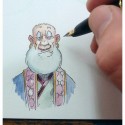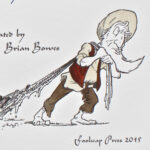Over the past year I’ve been working on a very special project called “The Story of the Fisherman.” Of course during the course of the project I’ve generated many many sketches, here are just a few. I hope you enjoy them.
Click on the thumbnails to see the images larger. There is also a “play button” in the bottom left corner of the pop-up window if you’d like a slide show!
You might also enjoy watching a time-lapse of me inking one of the final spreads for the book! It runs about 5:45 and shows the entire inking process from pencil to finish.
Here is the Youtube link, just in case the pop-up isn’t working for you.






Great Work (as always) Brian. I love the time-lapsed view of your inking. I’m particularly fascinated by the near constant motion of the paper beneath the pen nib. Too many years at a drafting table has gotten me into the habit of taping the paper down to a nearly horizontal table.
What are your thoughts on the difference between a free page and one that has been taped down? Does it matter enough to imagine those differences are the result of illustration styles? Perhaps choice in medium? (a sheet of wet watercolor paper can get pretty unruly if not thoroughly taped down)
Or is it simply personal preference?
Hi Patrick,
Thanks for your questions! I would definitely recommend a free piece of paper. Even when I do watercolors, I have taken to stapling the paper to a lightweight board that I can rotate around.
The reason I believe it is important to have a free floating piece of paper is because as you are making your marks on the page, either in a drawing or painting, you should be drawing the pen or brush toward yourself. Rather than pushing it away. So when it comes to making a curve or different angled crosshatching’s, it seems much easier to just rotate the paper or the board.
Does that make sense? Let me know what you think.
Howdy Brian,
I love the idea of mounting the watercolor paper to a free piece of board. I did something similar when illustrating LITTLE MONK & THE MANTIS, except I used plexiglass which allowed me to make use of a light-box as well.
I like the idea of “drawing” the pen/brush towards one’s self, I seem to recall the teacher describing it as towards the direction of your drawing hand, Right if your right handed or Left for south-paws. I certainly remember the warm-up exorcises he had us do; fill a page (a large page, tabloid or larger) with free-hand drawn horizontal and then vertical lines, evenly spaced and STRAIGHT!
What I also find interesting (tangent) is that this runs counter to some of the methodology behind Chinese style calligraphy and brush work. In such a case the brush is meant to be held vertically and strokes are to move in any direction needed (sometimes very specific directions for Chinese characters) while the body and the paper remain steady.
Or in some rare cases the calligrapher stands on a crate of eggs to demonstrate his steadiness.
Patrick, I expect to see a YouTube of you painting on top of a crate of eggs by next week!
Said eggs will be thoroughly scrambled!!
But . . . I’ve seen it done: https://www.youtube.com/watch?v=hbuZkac5QpA#t=154
in person.
Plus another example of Chinese Calligraphy I had a great time filming: http://youtu.be/lOm51GvdbgM
[…] page illustration is hand colored by the artist and makes for one amazing presentation. {Ed. Note: See here for an excellent look at the life of this project, full of sketches and a video, all of which gives […]
[…] “The Story of the Fisherman” Sketches and Video […]